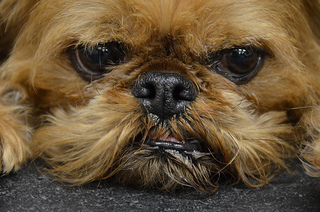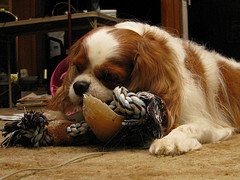Many dog lovers are aware of the problems with purebreds. “Pure breeding” involves mating animals with desirable characteristics within the same breed of dog, be they chihuahuas or golden retrievers. These closed gene pools lead to inbreeding, which increases the risk that puppies will develop hip displaysia, heart disease, epilepsy, and even cancer.
Breeding for desired physical characteristics in toy breeds can also cause serious brain disorders. Just last week, researchers
at the University of Surrey released a new study on dogs with Chiari malformations – a condition where the lower portions of the brain droop into the spinal column. This causes intense headaches, coordination problems, and occasionally paralysis.
In Cavalier King Charles Spaniels, Chiari malformations can also cause scoliosis, making these unfortunate dogs one of the few natural animal models for studying scoliosis in humans. 10-15% of human patients suffer from juvenile idiopathic scoliosis, which develops between ages 3-10 years; 20% of these children have underlying conditions, one of which is the Chiari malformation. In both dogs and people, brain surgery to repair the malformation may also cure its effects, including scoliosis.
At genetic and developmental levels, dogs and people have a lot in common, so the existence of puppies with severe health conditions is incredibly useful in medical research. Scientists do not breed to produce dogs with health conditions – they study dogs who happen to be afflicted. Generally speaking, the chance of finding such dogs is much higher among pure breds. If breeders could purge these conditions from their dogs, the animals themselves would be better off, but we would lose an opportunity to learn about human disease.

Brussels Griffons also suffer from Chiari malformations. Photo courtesy of andreaarden via Flickr Commons
What’s more important – the health of the dogs, or the possibility of helping people? I don’t know the answer, but I’m interested to hear what you think:
Do you own a pure bred dog? What responsibilities do you think breeders have towards they puppies they produce? How do you feel about the use of animals to study human health conditions? What is most ethical?
—
If you’re interested in learning more about scoliosis, check out my new book for teens with the condition, Living With Scoliosis.

Our dog, Tex, was a Portuguese Water Dog. I researched a lot about the breed and the breeders. Most of the breeders are a stubborn lot–everything revolves around the health and quality of tests and standards and care. I was (still am) impressed with the way they brought the breed back from near extinction.
Tex was a beautiful dog, even if he wasn’t considered show quality.
What makes me sad about some pure breeds is that some show standards have evolved to include traits that make life impossible for the dogs. Why is it necessary for bulldogs to have such narrow hips and big heads that the females have to have C-sections because they can’t physically give birth? (I know someone who has bred show dogs.) It doesn’t seem logical to me.
I totally agree, Diana – the health of the dog should never be compromised to fit people’s sense of aesthetics. I think that we have a responsibility to our domestic animals to give them the best lives they can possibly have, which includes breeding them for health as well as beauty.